Fly Fishing Terms.
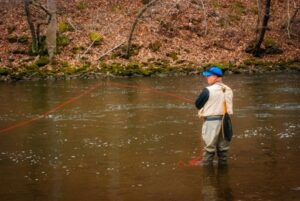
Fly fishing is an addictive hobby, sport and for some a lifestyle. But it also can contain a lot of confusing abbreviations, fly fishing terms and phrases.
Fly fishing seems to have its own in house words, even its own language, so in this article we will cover the glossary of fly fishing terms.
Abdomen – The rear section of a fly or insect from tail to thorax.
Action – How the fly rod behaves when flexing and bending during casting. It might have a slow or fast action.
Adult – The insects full grown stage of development.
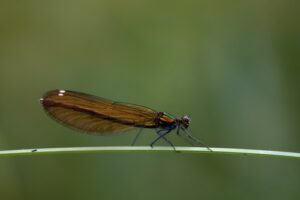
Attractor Flies – Flies not specifically designed to imitate a certain insect or bait closely.
Abor knot – A knot used to tie the fly line backing to the fly reel.
Ant pattern – An artificial fly pattern that copies an ant.
Back cast – When you cast the fly line backwards, the fly line travels behind the angler. It then extends out backwards and loads up the rod to travel forwards again. When the fly line goes backwards, it is known as a back cast.
Bass Bug – A bass fly or lure that is fished on the water’s surface. It might be tied with buoyant material such as deer hair. It is designed to place a lot water and make a lot of vibrations and movement.
Bass Bug Taper – A type weight forward fly line that can help cast in windy conditions and with bigger bass flies.
Blood Knot – It is used to tie two pieces of fishing line together, such as a leader and tippet. It can also be called a barrel knot.
It is a popular knot to use for older designed leaders as well. (That are not tapered, but are made out of different sections of breaking strains of line.)
Breaking Strength – The amount of force that is required to break fishing line. It is normally rated in pounds and the fishing line should have no knots in it.
Caddis – A common insect that looks like a small moth flying about around the water and water’s edge. It can be exciting fly fishing when trout are feeding on caddis skating across the water.
Casting Arc – The fly rod will follow a path or arc when casting.
Clinch Knot – A common knot used for connecting flies and hooks and swivels to the fishing line or tippet.
Dead Drift – The fly is travelling at the same pace as the current making it present more natural. The term can be used for both dry, nymphs and wet flies drifting.
Double Taper – A fly line design in which both ends taper down thinner than the main center fly line.
The double taper line might be referred to as “DT” on fly line packaging.
A double taper line cast present or roll over an imitation fly nicely on the water with a good leader and tippet setup. Although it isn’t ideal for bigger bas flies or windier conditions.
Drag – The term drag mean two things in fly fishing terms. Number one is the amount of tension on the fly reel and line when fighting a fish.
Number two is when the fly or line is floating with the current, but may have an unnatural pull on the line. (As opposed to a dead drift which may look more natural.)
Dry Fly – A fly that is fished on top of the water’s surface is called a dry fly. As opposed to a fly that is fished underneath the surface is called a wet fly.
Dry flies might represent a terrestrial insect or an aquatic insect emerging onto the water’s surface.
Dry Fly Floatant – This can be applied to dry flies to help it stay afloat and not sink.
Dry fly floatant, depending on the brand might be a spray, gel or paste. Some floatants can also be used on the tippet and leader to help the line stay afloat.
False Cast – This is the action of casting the fly in between lifting the line of the water and casting it and shooting the line back into the water.
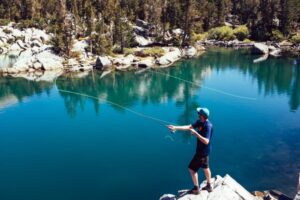
A false cast is normally used to shoot more line out once the line has been retrieved in. A false cast call also be used for changing direction when casting.
Floating Fly Line – Another term is the floating fly line which means the line will float on the water’s surface. As opposed to a sinking fly line or intermediate line that will sink.
Fly Line – A fly line is the main line that when used with a fly rod helps cast out the line. It has weight and available in different functions, such as floating or sinking.
The fly line can also have many designs and tapers, such as weight forward taper. The fly line is normally matched to the fly rod in a weight, such as a 5 weight line will suit a 5 weight fly rod.
Click on, How To Select A Fly Line for more information.
Fly Reel – A basic fishing reel designed to hold the fly line and backing. Most fly reels will have a drag setting. The reels come in a few sizes and are designed to roughly hold the fly line size. Such as the fly line might be a 7 weight, so the reel should be bigger enough to hold this size line and backing.
A saltwater fly fishing reel will be bigger and should have a good drag for bigger fish. Some saltwater fly reels will have a higher gear ratio. Also most saltwater fly reels are built of corrosion resistant materials for the salt water fishing.
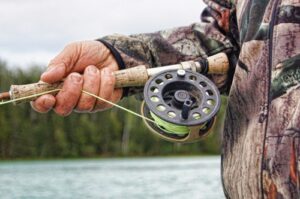
Fly Rod – A fly rod is designed to cast a fly line efficiently by loading up the fly line when casting.
Most fly rods are made of carbon, but some rods are made of bamboo or fiberglass.
A fly rod has a designated number on it known as a weight. This weight of the rod should match the weight of the fly line. As an example a 5 weight rod should work best with a 5 weight fly line. Otherwise the line might be too heavy or too light for the fly rod too cast the line properly.
Forceps – Use to remove hooks from the fish’s mouth. Fly fishing forceps are similar to the medical forceps.
Forward Cast – The forward cast means the front part of the cast, in front of the angler.
Graphite – A material used in rod building. The terms is interchangeable in fishing circles with carbon or carbon fiber.
Hackle – A feather normally tied around ta dry fly in fly tying to help it sit on the water’s surface. A hackle might also be used for a wet fly to give the fly movement when pulled through the water.
Hollow Hair – Fly tying material, which is normally hair from a deer. The hollow hair properties make it good for buoyant floating flies.
Hook – The artificial fly is tied around the hook. Hooks can range from very tiny to a large size to suit the fish species and techniques used.
Imitative Flies – A fly tied to closely imitate or match a certain insects. If the fish are selectively feed on one type of insect or bait, an imitative fly might be best used. This can be called “matching the hatch.”
Impressionistic Flies – An impressionistic fly might not exactly match one type of bait or insect the fish are feeding on, but can be used to represent some assorted food sources the fish might eat.
Indicator – An indicator can give a visual sign that a fish has taken the fly. It is normally a bit of buoyant material placed on the end of the fly line or leader. It can also help show how the line is drifting.
For an indicator, you might have a nymph fly pattern on and use a dry fly on the surface as an indicator when the nymph has been taken by the fish.
Knotless Tapered Leader – A leader that tapers down and has no knots in it. It is attached to the fly line one end and a tippet is put on the other end of the leader. (A knotted leader is tied in sections of line and has knots to connect them together.)
Leader – The fly fishing leader is similar properties to fishing line. It connects to the fly line and tippet. The tapered design helps roll over and cast the fly.
Level Line – A fly line that has straight design and no taper.
Loading the Rod – When the fly rod flexes when casting, it is like a slingshot ready to cast or shoot the line out.
Mayfly – The adult stage of a certain type of aquatic insect. A Mayfly might also be called a dun.
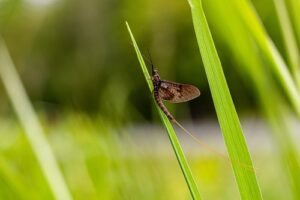
When it is in the nymph stage it lives in the water, then eventually swims to the surface and hatches into a flying insect. It looks like a small sail ship when floating on the water’s surface before flying off. A mayfly will then change into a spinner.
Mending Line – Mending the fly line is a method to give the line a more natural floating movement, which in turns make the imitation fly look more natural when floating or under the water’s surface.
Mending the line can be an art and science all in one when it comes to fast flowing rivers or windy lakes.
Midge – A small insect that fish feed on. They can sometimes swarm in groups, and look similar to mosquitos. The midge’s scientific name is called Chironomidae.
When fish are feeding on midges it can be very challenging as the tiny size is hard imitate. Also sometimes there are hundreds on the water and it is hard to fool the fish into taking your presentation.
Monofilament – Clear fishing line that might be used for tippet material when fly fishing.
Mud – A brown / grey clay, paste or gel that can be used on the leader, tippet to help sink the line. It can also be used on the actual fly line and fly to help sink them.
Nail Knot – A certain type of knot that is normally used in fly fishing to attach the fly line and leader together.
Narrow Loop – A fly fishing term when being cast in the air has a tight narrow loop. This loop can help cut into the wind and air and is a desirable casting action.
Nymph – An aquatic insects in the early stages of its life. A nymph in fly fishing circles might cover a wide range of aquatic insects, from dragonfly nymphs to a mayfly in its aquatic early stage.
Also the word nymph is used to describe a fly pattern that imitates the insect.
Nymphing – Used to describe fish eating nymphs.
Open Loop – An open loop is a wide loop when fly casting. For lack of a better word, it hasn’t got a streamlined narrow loop that can help it cast more efficiently through the air.
Pattern – Used to describe the artificial fly that represents a type of baitfish, insect or food.
Pick-up and Lay Down – The act of picking up the fly line and laying it back down on the water. There is no false casting involved.
Popping Bug – Designed to for a top water pattern for chasing bass and other fish. A popping bug might be made from foam, balsa wood, plastic or cork.
Presentation – Presenting the fly so that it will entice the fish to bite.
Reel Seat – The area on the rod designed to hold the reel. It might have a band or rings to secure the reel in place.
Retrieve – When the fly line and the fly is cast out, it is the act of bringing in the fly closer to the angler. It is normally done by slowly retrieving the line, or rapidly stripping the line back quickly.
The retrieve rate will depend on the fish species targeted, type of fly and technique used.
Rod Flex – This is how the rod bends. Some rods can bend more through the tip, other fly rods can flex more on the whole rod.
Roll Cast – The rod is lifted up causing the fly line to lift up and then with a flick of the wrist, the fly line is flicked back down onto the water. There is no back cast or false casting involved. The motion of the fly line landing back on the water makes it rollover, giving it the name, roll cast.
The roll cast is handy for when the angler has trees or a rock face behind them, so it is hard to cast normally. The roll cast might be used to pick up a sinking fly line so it can be retrieved easier.
Running Line – A line attached to a shooting head fly line. The angler can change the head section.
“S” Cast – An “S” cast is used to describe the technique of putting some slack fly line on the water. This helps when mending the fly line.
Saltwater Taper Fly Line – A weight forward fly line that helps cast into the wind and cast bigger flies.
Setting the Hook – Setting the hook is when you firmly and quickly lift the rod up when you feel the fish bite and the hook goes into the fish’s mouth to hold it. It might be referred to as striking the fish or strike.
Shank – The long part of the hook that connects to the eye. Not the point or barb of the fish hook.
Shooting Taper – A tapered fly line that can be swapped with other shooting headlines. They are designed for long distance casting s are designed for longest casts for chasing salmon, and steelhead.
Sink Rate – A sinking fly line will have a certain rate it sinks. For an example, such as 5 inches per second. You can buy different types of sinking fly lines that can range from a slow sink rate to a fast rate.
Sink-Tip Fly Line – The main line is a floating line, but the end or tip of the fly line sinks.
Sinking Fly Line – Designed to sink underneath the water. You can get different types of sinking lines that have different sink rates. (How fast the line sinks.)
Smelt – Use to describe small baitfish that the fish are feeding on. A smelt pattern is a fly that resembles a baitfish. Smelt can also be known as fry.
Smelting – In fly fishing terms it is used to describe the action the fish use when feeding on small baitfish. Smelting can be a very exciting type of fishing as the fish or trout charge and round up the baitfish. The trout can even charge into the shallow waters causing the baitfish to jump in the air to escape the predator trout.
Spool – A part of the fly reel that holds the fly line and backing. Some fly reels have interchangeably and spare spools so you can swap your fly line set up.
Stonefly – Stoneflies (Plecoptera.) are an aquatic insect. Just like mayfly’s they have a life cycle that goes from a nymph stage living in the water to an adult stage. The adult stonefly can fly, although there is one species of Stonefly that lives its life just in the water.
Streamer – Normally a bigger fly pattern that imitates baitfish. Streamers can be popular for salmon fishing.
Stripping Basket – A basket or tray that you put the fly line in when retrieving or stripping the line.
The stripping basket is normally worn around the waist and stops the fly line from getting tangled at the feet, in foliage.
Some saltwater fly fisherman use one when wading so the wave action doesn’t constantly pull the fly line about. It might be made out of mesh so the water drains easy off.
Stripping Line – Retrieving the line by quickly pulling the line in. It is generally a long pull of the line and used for faster retrieves, rather than a slow retrieve.
Surgeon’s Knot – A versatile fishing knot that can be used to tie two bits of fishing line together.
Tag End – A tag or tag end is the end of the fishing line when tying knots. Or the main end bit you use to thread through the eye of the hook or tie the knot.
It can also be referred to the working end. It is the bit that sticks out after you have tied the knot.
Tapered Leader – A leader that is tapered down. The bigger diameter end of the leader will be tied to the fly line. On the other end, the smaller diameter leader will be attached to the tippet material.
Tippet – The tippet section line is tied to the leader. The other end attaches to the fishing hook or fly.
It is normally fishing line that is monofilament or fluorocarbon material.
A tippet is designed so you can change flies easily without using bits of your leader up. Also you can change tippets to suit the conditions, fly size and fish. For example if you are targeting bigger fish you might tie on a heavier tippet section. For smaller fish a lighter pound breaking strain line might be used.
Turn Over – A fly fishing term to describe how the fly line, leader and tippet roll over and lay out when presented on the water.
Unloading the Rod – The energy is used to cast the fly line when the road becomes back from the flexed position to normal.
Click on How To Fly Fish For Casting Tips.
Waders – Waders are waterproof and come in a few designs from thigh waders, waist and chest waders.
As well as the length there are two main types, bare foot waders and stocking foot waders. Bare foot waders have the boot attached. Stocking foot waders are like a sock and need a wading shoe or boot to go over it.
Waders can be made of a neoprene wetsuit type material or a PVC type material.
Wading Shoes – Boots or shoes made to be worn over stocking foot waders.
Weight Forward – A fly line that has a taper and design where a lot of the weight is in the forward section of the fly line. A weight forward line can help cast bigger flies and help with casting into some wind.
Wet Fly – A fly fished below the water’s surface. As opposed to a dry fly fished on top of the water’s surface.
Wind Knot – A knot in the tippet or leader that can happen when casting. It can be frustrating to get it out and can occur on windy days when fly fishing. The line should be checked frequently for wind knots as it can weaken the strength of the tippet or leader
Conclusion – Fly fishing terms.
There certainly is a different language and lingo for fishing, especially fly fishing.
We hope you have enjoyed this list of fly fishing terms and phrases.
Extra Resources
